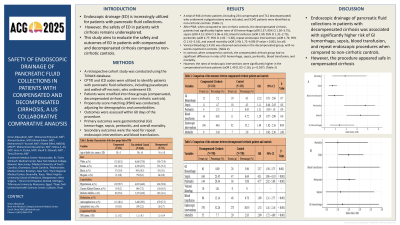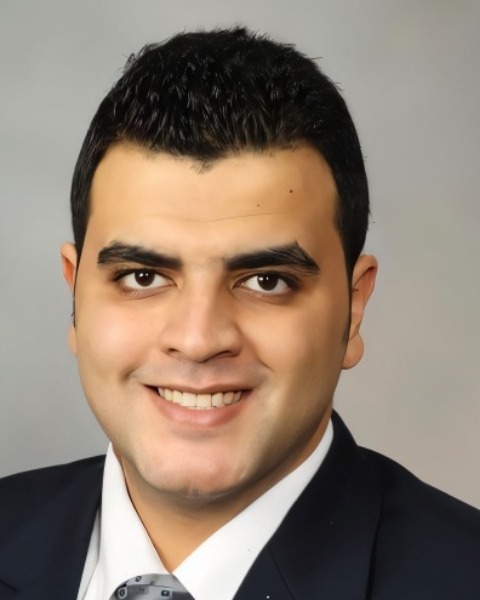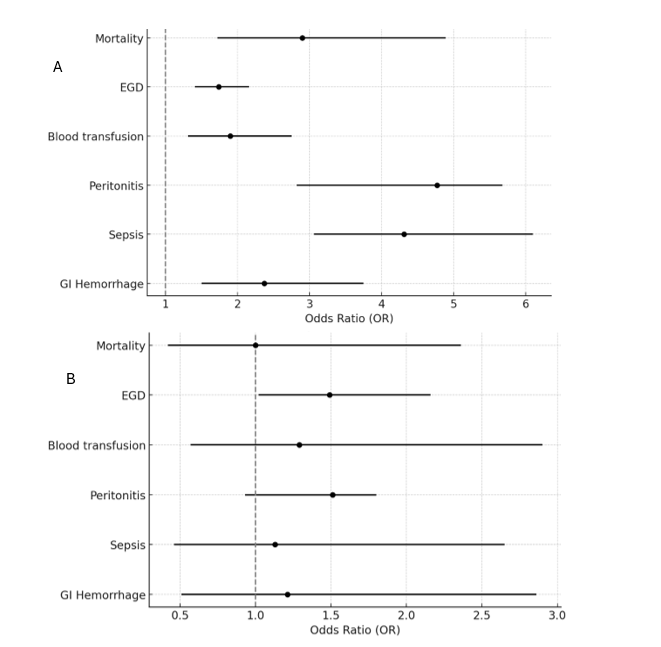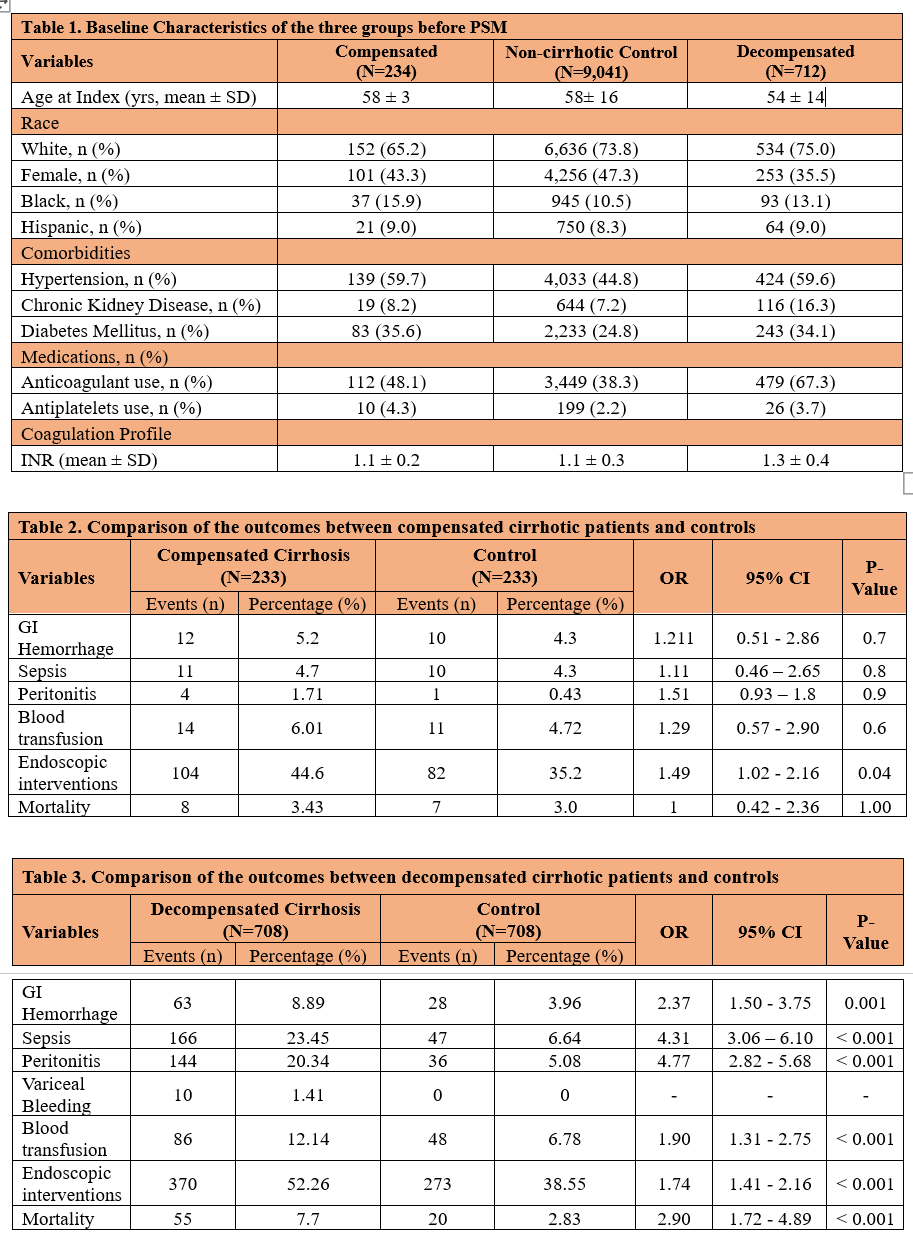Sunday Poster Session
Category: Interventional Endoscopy
P1380 - Safety of Endoscopic Drainage of Pancreatic Fluid Collections in Patients With Compensated and Decompensated Cirrhosis, a US Collaborative Comparative Analysis
Sunday, October 26, 2025
3:30 PM - 7:00 PM PDT
Location: Exhibit Hall


Mohamed Eldesouki, MD
Saint Michael's Medical Center, New York Medical College
Newark, NJ
Presenting Author(s)
Mohamed Eldesouki, MD1, Ahmed Ibrahim, MD2, Ahmed Salem, MD3, Mohammed Y. Youssef, MD4, Khaled Elfert, MBChB, MRCP5, Mohammed Abusuliman, MD6, Mona A. Ali, MD7, Anas A. Elsaka, MD7, Sherif E. Elhanafi, MD8
1Saint Michael's Medical Center, New York Medical College, Newark, NJ; 2Medical University of South Carolina, Charleston, SC; 3Maimonides Medical Center, Brooklyn, NY; 4Hunt Regional Medical Center, Greenville, TX; 5West Virginia University School of Medicine, Morgantown, WV; 6Henry Ford Hospital, Detroit, MI; 7Mansoura University, Mansoura, Ad Daqahliyah, Egypt; 8Texas Tech University Health Sciences Center, El Paso, TX
Introduction: Endoscopic drainage (ED) is increasingly utilized for patients with pancreatic fluid collections. However, the safety of ED in patients with cirrhosis remains underexplored. This study aims to evaluate the safety and outcomes of ED in patients with compensated and decompensated cirrhosis compared to non-cirrhotic controls.
Methods: A retrospective cohort study was conducted using the TriNetX database. CPT© and ICD codes were utilized to identify patients with pancreatic fluid collections, including pseudocysts and walled-off necrosis, who underwent ED. Patients were stratified into three groups (compensated, decompensated cirrhosis, and non-cirrhotic controls). Propensity score matching (PSM) was conducted, adjusting for demographics and comorbidities. Outcomes were assessed within 60 days of the procedure. Primary outcomes were gastrointestinal (GI) hemorrhage, sepsis, peritonitis, and overall mortality. Secondary outcomes were the need for repeat endoscopic interventions and blood transfusions.
Results: A total of 946 cirrhotic patients (including 234 compensated and 712 decompensated) who underwent cystgastrostomy were included, and 9,041 patients were identified as non-cirrhotic controls. (Table 1). After PSM, when compared to non-cirrhotic controls, the decompensated cirrhosis patients had significantly higher rates of GI hemorrhage (aOR 2.37; 95% CI 1.50–3.75), sepsis (aOR 4.31; 95% CI 3.06–6.10), blood transfusion (aOR 1.90; 95% CI 1.31–2.75), peritonitis (aOR 4.77; 95% CI 2.82 – 5.68), repeat endoscopic interventions (aOR 1.74; 95% CI 1.41–2.16), and overall mortality (aOR 2.90; 1.72–4.89) (P value < 0.001, for all). Variceal bleeding (1.41%) was observed exclusively in the decompensated group, with no events reported in controls. (Table 2). In contrast, when compared to controls, the compensated cirrhosis group had no significant difference in rates of GI hemorrhage, sepsis, peritonitis, blood transfusion, and mortality. However, the rates of endoscopic interventions were significantly higher in the compensated cirrhosis patients (aOR 1.49 (1.02–2.16), p = 0.037). (Table 3)
Discussion: Endoscopic drainage of pancreatic fluid collections in patients with decompensated cirrhosis was associated with significantly higher risk of GI hemorrhage, sepsis, blood transfusion, and repeat endoscopic procedures when compared to non-cirrhotic controls. However, the procedure appeared safe in compensated cirrhosis


Disclosures:
Mohamed Eldesouki, MD1, Ahmed Ibrahim, MD2, Ahmed Salem, MD3, Mohammed Y. Youssef, MD4, Khaled Elfert, MBChB, MRCP5, Mohammed Abusuliman, MD6, Mona A. Ali, MD7, Anas A. Elsaka, MD7, Sherif E. Elhanafi, MD8. P1380 - Safety of Endoscopic Drainage of Pancreatic Fluid Collections in Patients With Compensated and Decompensated Cirrhosis, a US Collaborative Comparative Analysis, ACG 2025 Annual Scientific Meeting Abstracts. Phoenix, AZ: American College of Gastroenterology.
1Saint Michael's Medical Center, New York Medical College, Newark, NJ; 2Medical University of South Carolina, Charleston, SC; 3Maimonides Medical Center, Brooklyn, NY; 4Hunt Regional Medical Center, Greenville, TX; 5West Virginia University School of Medicine, Morgantown, WV; 6Henry Ford Hospital, Detroit, MI; 7Mansoura University, Mansoura, Ad Daqahliyah, Egypt; 8Texas Tech University Health Sciences Center, El Paso, TX
Introduction: Endoscopic drainage (ED) is increasingly utilized for patients with pancreatic fluid collections. However, the safety of ED in patients with cirrhosis remains underexplored. This study aims to evaluate the safety and outcomes of ED in patients with compensated and decompensated cirrhosis compared to non-cirrhotic controls.
Methods: A retrospective cohort study was conducted using the TriNetX database. CPT© and ICD codes were utilized to identify patients with pancreatic fluid collections, including pseudocysts and walled-off necrosis, who underwent ED. Patients were stratified into three groups (compensated, decompensated cirrhosis, and non-cirrhotic controls). Propensity score matching (PSM) was conducted, adjusting for demographics and comorbidities. Outcomes were assessed within 60 days of the procedure. Primary outcomes were gastrointestinal (GI) hemorrhage, sepsis, peritonitis, and overall mortality. Secondary outcomes were the need for repeat endoscopic interventions and blood transfusions.
Results: A total of 946 cirrhotic patients (including 234 compensated and 712 decompensated) who underwent cystgastrostomy were included, and 9,041 patients were identified as non-cirrhotic controls. (Table 1). After PSM, when compared to non-cirrhotic controls, the decompensated cirrhosis patients had significantly higher rates of GI hemorrhage (aOR 2.37; 95% CI 1.50–3.75), sepsis (aOR 4.31; 95% CI 3.06–6.10), blood transfusion (aOR 1.90; 95% CI 1.31–2.75), peritonitis (aOR 4.77; 95% CI 2.82 – 5.68), repeat endoscopic interventions (aOR 1.74; 95% CI 1.41–2.16), and overall mortality (aOR 2.90; 1.72–4.89) (P value < 0.001, for all). Variceal bleeding (1.41%) was observed exclusively in the decompensated group, with no events reported in controls. (Table 2). In contrast, when compared to controls, the compensated cirrhosis group had no significant difference in rates of GI hemorrhage, sepsis, peritonitis, blood transfusion, and mortality. However, the rates of endoscopic interventions were significantly higher in the compensated cirrhosis patients (aOR 1.49 (1.02–2.16), p = 0.037). (Table 3)
Discussion: Endoscopic drainage of pancreatic fluid collections in patients with decompensated cirrhosis was associated with significantly higher risk of GI hemorrhage, sepsis, blood transfusion, and repeat endoscopic procedures when compared to non-cirrhotic controls. However, the procedure appeared safe in compensated cirrhosis

Figure: Table 1. Baseline Characteristics of the three groups before PSM
Table 2. Comparison of the outcomes between compensated cirrhotic patients and controls
Table 3. Comparison of the outcomes between decompensated cirrhotic patients and controls
Table 2. Comparison of the outcomes between compensated cirrhotic patients and controls
Table 3. Comparison of the outcomes between decompensated cirrhotic patients and controls

Figure: Figure. A) Odds ratios for the outcomes of decompensated cirrhotic patients and controls, B) Odds ratios for the outcomes of compensated cirrhotic patients and controls
Disclosures:
Mohamed Eldesouki indicated no relevant financial relationships.
Ahmed Ibrahim indicated no relevant financial relationships.
Ahmed Salem indicated no relevant financial relationships.
Mohammed Y. Youssef indicated no relevant financial relationships.
Khaled Elfert indicated no relevant financial relationships.
Mohammed Abusuliman indicated no relevant financial relationships.
Mona Ali indicated no relevant financial relationships.
Anas Elsaka indicated no relevant financial relationships.
Sherif Elhanafi indicated no relevant financial relationships.
Mohamed Eldesouki, MD1, Ahmed Ibrahim, MD2, Ahmed Salem, MD3, Mohammed Y. Youssef, MD4, Khaled Elfert, MBChB, MRCP5, Mohammed Abusuliman, MD6, Mona A. Ali, MD7, Anas A. Elsaka, MD7, Sherif E. Elhanafi, MD8. P1380 - Safety of Endoscopic Drainage of Pancreatic Fluid Collections in Patients With Compensated and Decompensated Cirrhosis, a US Collaborative Comparative Analysis, ACG 2025 Annual Scientific Meeting Abstracts. Phoenix, AZ: American College of Gastroenterology.
